
Catalog excerpts

Implants trauma Hallux Osteotomy Locking Plate
Open the catalog to page 1
CAUTION: Federal Law (USA) restricts this device to sale by or on the order of a board certified physician. WARNING: If there is no sufficient bone healing, wrong or incomplete postoperative care, plate might break. All ITS plates are preformed anatomically as a matter of principle. If adjustment of the plate to the shape of the bone is required, this is possible by carefully bending gently in one direction once. Particular care is required when bending in the region of a plate hole, as deformation of the plate may lead to a failure of the locking mechanism. The plate must not be buckled or...
Open the catalog to page 2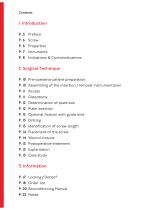
1. Introduction P. 5 Preface P. 6 Screw P. 6 Properties P. 7 Intruments P. 8 Indications & Contraindications 2. Surgical Technique P. 10 Pre-operative patient preparation P. 10 Assembling of the insertion / removal instrumentation P. 11 Access P. 11 Osteotomy P. 12 Determination of plate size P. 12 Plate insertion P. 12 Optional fixation with guide wire P. 13 Drilling P. 13 Identification of screw length P. 14 Placement of the screw P. 14 Wound closure P. 15 Postoperative treatment P. 15 Explantation P. 15 Case study 3. Information P. 17 Locking / Dotize® P. 18 Order list P. 20...
Open the catalog to page 3
Preface The Hallux Osteotomy Locking Plate from ITS. is an intramedullary self-locking plate for distal metatarsal osteotomies. When the screw is inserted the 2 flanks are splayed out, and the implant acquires a firm intramedullary hold. The special feature of this implant is the ability to choose your preferred osteotomy technique, the simple and brief surgical procedure, the stable implant position and weightbearing.
Open the catalog to page 5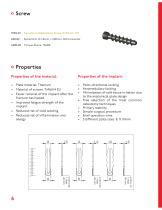
Cancellous Stabilization Screw, D=3.0mm, RH Spiral Drill, D=1.8mm, L=100mm, AO Connector Properties Properties of the material: • Plate material: Titanium • Material of screws: TiAl6V4 ELI • Easier removal of the implant after the fracture has healed • Improved fatigue strength of the implant • Reduced risk of cold welding • Reduced risk of inflammation and allergy • Multi-directional locking • Intramedullary locking • Minimization of soft tissue irritation due to the anatomical plate design • Free selection of the most common osteotomy techniques • Primary stability • Simple surgical...
Open the catalog to page 6
Depth Gauge: • One-hand design • Ability to measure through the insertion / removal instrumentation Insertion / removal instrumentation: Implant Depth Gauge: • AO Connector • Plateau for simple insertion & removal • Ability to insert the screw through the insertion / removal instrumentation • 3-star implant depth gauge to measure the correct plate size
Open the catalog to page 7
Indications, Contraindications Indications: • Intramedullary self-locking plate for distal metatarsal osteotomies • For Hallux Valgus up to a corrective angle of 25° Existing bone or soft tissue infections at the surgical site Common situations that do not allow osteosynthesis With advanced osteoporosis Skin and soft-tissue problems which prevent a tension-free closure of the skin Obesity Lack of patient compliance
Open the catalog to page 8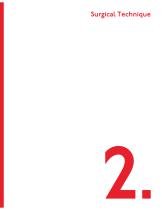
Surgical Technique
Open the catalog to page 9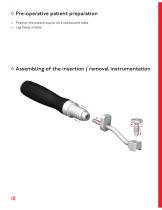
Pre-operative patient preparation • Position the patient supine on a radiolucent table • Leg freely mobile Assembling of the insertion / removal instrumentation
Open the catalog to page 10
Access Medial access • Access is on the medial side of the first metatarsal bone subcapitally (osteotomy height) to distal of the base of the joint of the first metatarsal bone. • Dependent on the hospital, execution of a lateral capsulotomy and tenetomy. • Horizontal capsular incision and removal of the thickened capsular lobe from the extosis (potential fusiform capsular resection). Osteotomy • Leveling of the plate bed or removal of the pseudoextosis with a finely oscillating saw. Not to exceed the level of the shaft diaphysis. The smoothened surface acts as a bed for the plate head. •...
Open the catalog to page 11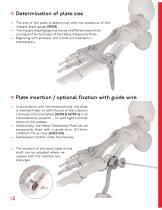
Determination of plate size • The size of the plate is determined with the assistance of the implant depth gauge (59028). • The implant depth gauge has 3 ends of different sizes which correspond to the 3 sizes of the Hallux Osteotomy Plate • Beginning with smallest, the 3 ends are inserted intramedullary Plate insertion / optional fixation with guide wire • In accordance with the measured size, the plate is inserted freely or with the aid of the insertion / removal instrumentation (62702 & 62702-5) in an intramedullary position - or with light hammer blows on the plateau. • Additionally,...
Open the catalog to page 12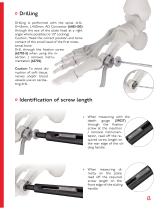
Drilling Drilling is performed with the spiral drill, D=1.8mm, L=100mm, AO Connector (61183-100) through the eye of the plate head at a right angle where possible (+/- 15° Locking). Caution: Heed the correct position and bone contact of the small head of the first metatarsal bone. Drill through the fixation screw (62702-5) when using the insertion / removal instrumentation (62702). Caution: To avoid disruption of soft tissue, nerves and/or blood vessels use an oscillating drill. Identification of screw length • When measuring with the depth gauge (59027) through the fixation screw at the...
Open the catalog to page 13
Placement of the screw • In accordance with the measured length, a cancellous stabilization screw, D=3.0mm, RH (37303-XX) is now inserted with the Torque-Shank, T9x100 (54095-100). • The screw can be inserted by the insertion / removal instrumentation (62702) or freely after removal of the fixation screw. • Final control under fluoroscopy. Caution: When inserting the screw ensure that the screw head is flush with the plate. Wound closure • • • • Suture the capsule with absorbable sutures Drainage is usually not necessary Suture the skin Apply the appropriate dressing
Open the catalog to page 14
Postoperative treatment • Elevation and preventative edema measures on the day of the operation • Mobilization with forefoot relief shoe • Free weightbearing according to symptoms and stipulations of the operating surgeon Explantation • Removal is possible, if desired by the patient. This is facilitated by the fact that cold welding never occurs. • Implant removal is performed after radiographic verification of the healed bone, vice versa of implantation • Skin incision following the old scar • Remove the screw with the Torque-Shank, T9x100 (54095-100) • Remove the plate simply by pulling...
Open the catalog to page 15All I.T.S. catalogs and technical brochures
-
ufs
1 Pages
-
DHL
2 Pages
-
ITS
2 Pages
-
PHL
24 Pages
-
ACLS
20 Pages
-
CFN
32 Pages
-
OLS
24 Pages
-
PHLs
20 Pages
-
CTN - Cannulated Tibia Nail
28 Pages
-
SR Sacral Rods
20 Pages
-
HCS
24 Pages
-
TOS Twist-Off Screw
20 Pages
-
TLS
20 Pages
-
PRS-RX
32 Pages
-
HLS
20 Pages
-
ES
20 Pages
-
SR
20 Pages
-
FL
24 Pages
-
PL - Pilon Locking Plate small
12 Pages
-
OL - Olecranon Locking Plate
24 Pages
-
CAS
40 Pages
-
FCN
20 Pages
-
FLS
24 Pages
-
PFL
20 Pages
-
DTL
24 Pages
-
HTO
24 Pages
-
PTL
32 Pages
-
DFL
32 Pages
-
SCL
32 Pages
-
SLS
24 Pages
-
CAL
20 Pages
-
DUL
24 Pages
-
CLS
28 Pages



























































